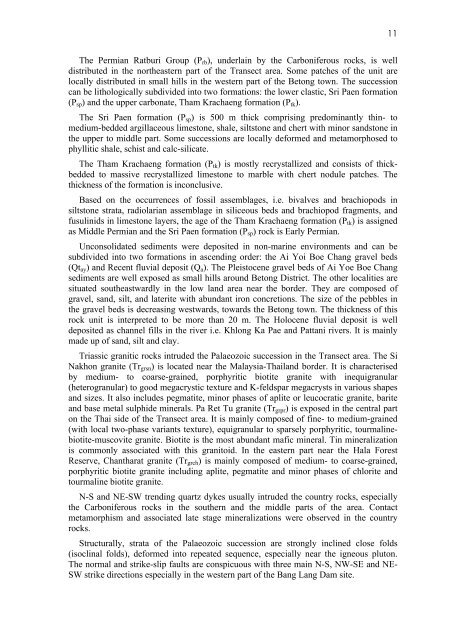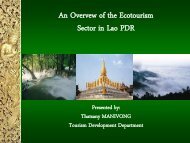GEOLOGY OF THE PENGKALAN HULU-BETONG TRANSECT ...
GEOLOGY OF THE PENGKALAN HULU-BETONG TRANSECT ...
GEOLOGY OF THE PENGKALAN HULU-BETONG TRANSECT ...
Create successful ePaper yourself
Turn your PDF publications into a flip-book with our unique Google optimized e-Paper software.
The Permian Ratburi Group (Prb), underlain by the Carboniferous rocks, is well<br />
distributed in the northeastern part of the Transect area. Some patches of the unit are<br />
locally distributed in small hills in the western part of the Betong town. The succession<br />
can be lithologically subdivided into two formations: the lower clastic, Sri Paen formation<br />
(Psp) and the upper carbonate, Tham Krachaeng formation (Ptk).<br />
The Sri Paen formation (Psp) is 500 m thick comprising predominantly thin- to<br />
medium-bedded argillaceous limestone, shale, siltstone and chert with minor sandstone in<br />
the upper to middle part. Some successions are locally deformed and metamorphosed to<br />
phyllitic shale, schist and calc-silicate.<br />
The Tham Krachaeng formation (Ptk) is mostly recrystallized and consists of thickbedded<br />
to massive recrystallized limestone to marble with chert nodule patches. The<br />
thickness of the formation is inconclusive.<br />
Based on the occurrences of fossil assemblages, i.e. bivalves and brachiopods in<br />
siltstone strata, radiolarian assemblage in siliceous beds and brachiopod fragments, and<br />
fusulinids in limestone layers, the age of the Tham Krachaeng formation (Ptk) is assigned<br />
as Middle Permian and the Sri Paen formation (Psp) rock is Early Permian.<br />
Unconsolidated sediments were deposited in non-marine environments and can be<br />
subdivided into two formations in ascending order: the Ai Yoi Boe Chang gravel beds<br />
(Qtay) and Recent fluvial deposit (Qa). The Pleistocene gravel beds of Ai Yoe Boe Chang<br />
sediments are well exposed as small hills around Betong District. The other localities are<br />
situated southeastwardly in the low land area near the border. They are composed of<br />
gravel, sand, silt, and laterite with abundant iron concretions. The size of the pebbles in<br />
the gravel beds is decreasing westwards, towards the Betong town. The thickness of this<br />
rock unit is interpreted to be more than 20 m. The Holocene fluvial deposit is well<br />
deposited as channel fills in the river i.e. Khlong Ka Pae and Pattani rivers. It is mainly<br />
made up of sand, silt and clay.<br />
Triassic granitic rocks intruded the Palaeozoic succession in the Transect area. The Si<br />
Nakhon granite (Trgrsn) is located near the Malaysia-Thailand border. It is characterised<br />
by medium- to coarse-grained, porphyritic biotite granite with inequigranular<br />
(heterogranular) to good megacrystic texture and K-feldspar megacrysts in various shapes<br />
and sizes. It also includes pegmatite, minor phases of aplite or leucocratic granite, barite<br />
and base metal sulphide minerals. Pa Ret Tu granite (Trgrpr) is exposed in the central part<br />
on the Thai side of the Transect area. It is mainly composed of fine- to medium-grained<br />
(with local two-phase variants texture), equigranular to sparsely porphyritic, tourmalinebiotite-muscovite<br />
granite. Biotite is the most abundant mafic mineral. Tin mineralization<br />
is commonly associated with this granitoid. In the eastern part near the Hala Forest<br />
Reserve, Chantharat granite (Trgrch) is mainly composed of medium- to coarse-grained,<br />
porphyritic biotite granite including aplite, pegmatite and minor phases of chlorite and<br />
tourmaline biotite granite.<br />
N-S and NE-SW trending quartz dykes usually intruded the country rocks, especially<br />
the Carboniferous rocks in the southern and the middle parts of the area. Contact<br />
metamorphism and associated late stage mineralizations were observed in the country<br />
rocks.<br />
Structurally, strata of the Palaeozoic succession are strongly inclined close folds<br />
(isoclinal folds), deformed into repeated sequence, especially near the igneous pluton.<br />
The normal and strike-slip faults are conspicuous with three main N-S, NW-SE and NE-<br />
SW strike directions especially in the western part of the Bang Lang Dam site.<br />
11



